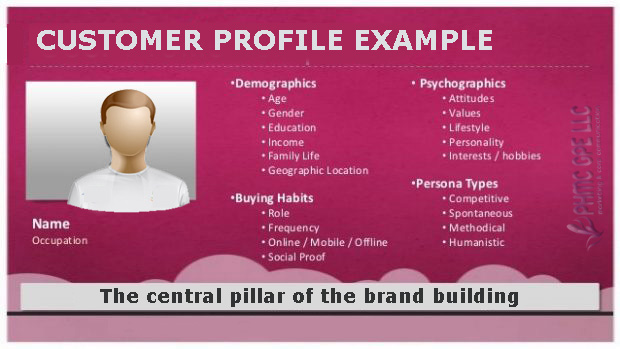Not all products in the market are meant for every consumer; rather a particular customer won’t use all the commodities available in the region. While some products cater to young people, there are others which exclusively focus on mature adults. Certain commodities are meant for women; likewise, there are products and services targeting men.
Therefore, before an organization thinks about launching a product or service, it has to first decide for whom they will make the commodity. Will they cater to teenagers or the working population or kids? Will the elite people use the product or the ordinary class? Everything about the commodity, including its price, packaging, place of promotion and the product itself depends on the most important factor, i.e. customer profile.
Therefore, a path of categorizing a brand’s consumers in such a way that it can identify them as a specific target and enable the company to prepare the marketing and advertising strategies accordingly is known as customer profile. The better band managers define their target audience specifically and sharply according to segments; commodity sales are bound to increase and witness a steady growth.
What is a customer profile?
A customer profile basically tells you everything about a customer, his demography, geography, psychological thinking, behavioral aspects etc. Making a customer profile is important for a company because any company wants to reach a target market. Therefore, to reach the target market, the company needs to understand the target customer profile which can be influenced through various marketing means.

Mainly, customers are of two types- business and retail. In either case, prior to plunging into business, brand managers consume a lot of time to collect customer information as a whole (such as location, purchasing power, spending frequency, etc), append additional consumer or business data, and then group consumers into segments that share similar characteristics.
How to create a Customer Profile for your target customers?
A customer profile is dependent on various factors. Brand managers, while defining their ideal customers, take into account the following components of the Customer profile
1) Demographics
It refers to the physical characteristics of age, gender, race, marital status, educational background, and occupation. Demographic classification of customers enables marketers to narrow down their consumer base from the entire mass, filter the most suitable consumer group and focus on a niche target audience. Without demographic data, brand developers will not be able to channelize their communication, promotional activities and other aspects of marketing. It is because the way a brand will talk to a younger audience will be different from addressing a more matured one. Physical characteristics of a college-going person will never be the same as that of a white-collar worker. In the same way, a bachelor’s life and married life are poles apart. Therefore, products aimed at unmarried people will have to be presented in a diverse way than presenting the same product to married consumers.
2) Standard of Living
The income factor assumes a greater importance in determining the standard of living of a consumer. Does the person belong to the labor class and live in chawls or is it someone having a settled life in an ordinary home or apartment? Does the consumer possess any two-wheeler or a car or has the potential to purchase one? Is the person a businessman or employee in an organization? What are the kinds of brands used by the person? How often does the consumer like to spend? Is he/she extravagant or savings minded? Solutions to all these questions help the company to draw a clear picture about the quality of living of its customers. Analyzing the living standard also gives an idea about the probable price range of the product which shall be accepted by the buyer. Besides these, it throws light on the kind of product packaging which shall woo the consumers.
3) Geographical Region
Another significant component of customer profile is the place where the customer belongs to. It is not the original birthplace but the place where the customer lives at the moment (if the native place and current residence differ). Brands can target people living in urban areas only or develop a mass appeal spanning across a vast geographical location, which may include a cluster of countries or an entire continent. As with limited budget brands, their target consumers may include a particular community or a region. Whatsoever, defining a proper geographical location paves way for creating a solid customer profile.
4) Psychographics
Next one to explore is the psychographics or mental characteristics that may include one’s nature, hobbies, interests, favorite TV shows, preferred music, lifestyle, websites, presence in virtual platforms, likes and dislikes, spending habits, anxieties, political views, community participation, social image, etc. Knowing such metrics shows a direction to brand developers about the kind of person to whom their brand will interact. They should ensure that the qualities of the brand match with its target audience, otherwise all branding activities will end in smoke.
5) Purchase History
It is of great help for companies if they launch products of similar nature to already what is available. For example, if a new chip or chocolate brand is launched, the brand managers will browse the purchase history of its customers pertaining to the product. This will give an idea about a probable number of customer visits which they shall expect over a period of time. It will further enable them to strategize their communication efforts so as to increase the frequency of consumer visits to purchase the product. Even though the organization might not launch a similar product, knowing the purchase history of a relatable product will definitely help the brand development team to learn about the probable number of sales which can be expected over a specific time period.
***
While keeping the above parameters in mind, it is not unusual for brands to have multiple customer profiles for their different product categories. For example, a company can launch three different types of skin care products, one for children, the other for ladies and the third one for senior women under the same brand name. In such a case, brands have to be extra careful while building the manifold profiles and equally work hard to maintain them.
After collating all the necessary information, the management can have an online database containing such information. In just one click, they shall be able to access and fetch the required customer profile data and carry out their further activities. On the whole, a strong and concrete profile of customers is integral to the acceptability of the product by the targeted consumers and the success of the brand, in the long run.
It is the central pillar of the brand building.
Sources: PHMC GPE LLC - Coffee Break - Marketing91 - HO1.us











